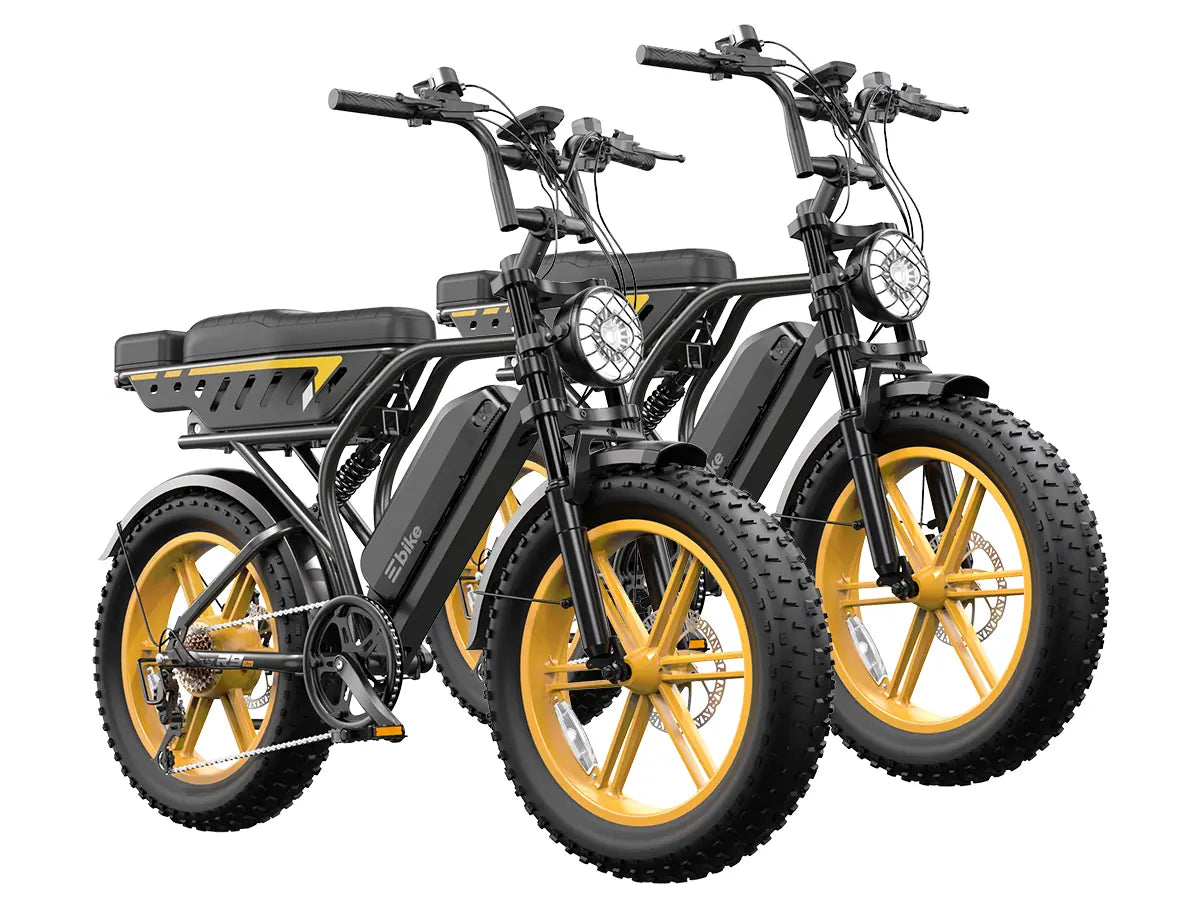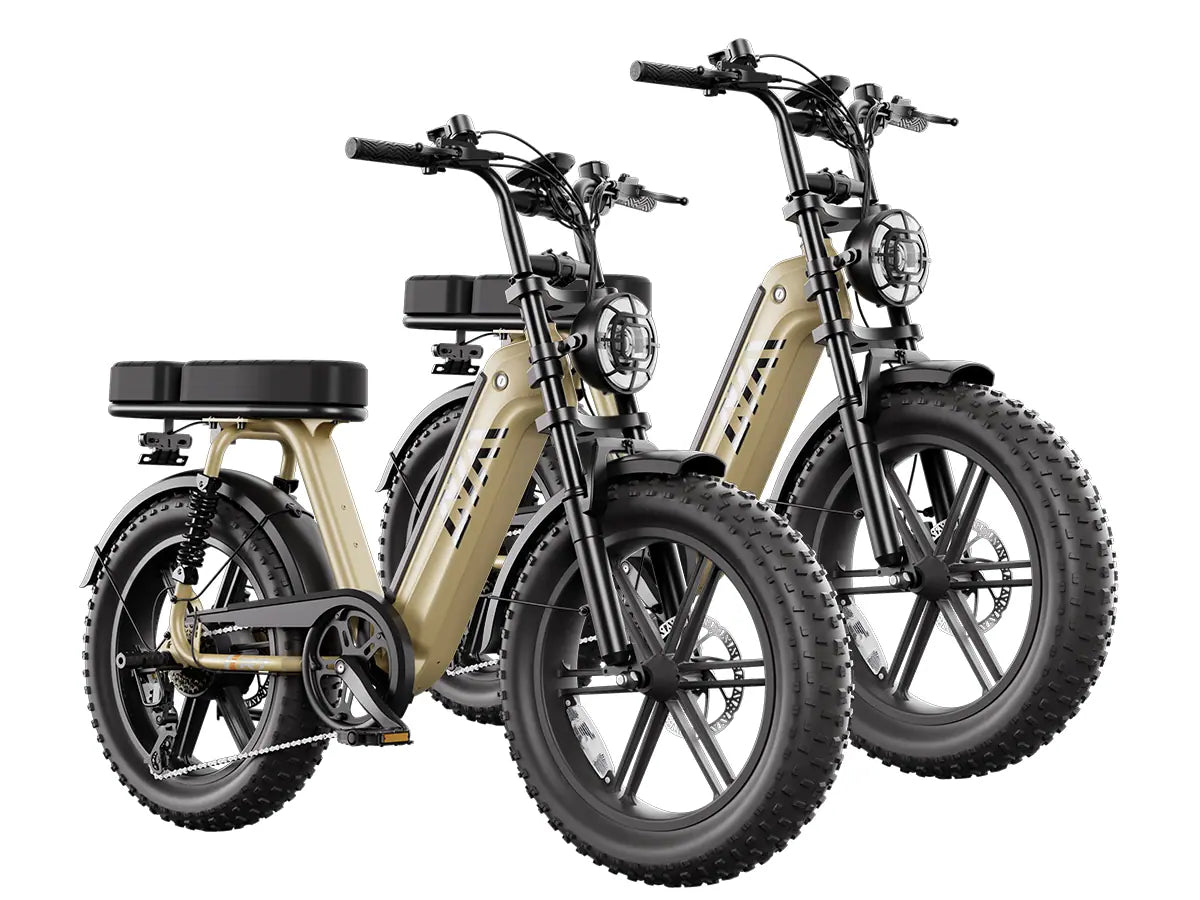A moped-style e-bike uses a throttle-controlled, high-power motor allowing for faster speeds and riding without pedaling, mimicking a traditional moped, while a regular electric bike relies mainly on pedal-assist, offering moderate speeds and a bike-like riding experience. Moped-style e-bikes are heavier with bigger motors; regular e-bikes are lighter, designed for fitness and commuting.
How Does the Power System Differ Between Moped-Style E-Bikes and Regular Electric Bikes?
Moped-style e-bikes typically incorporate both a throttle and pedal-assist system, enabling riders to accelerate solely using the throttle, thus requiring minimal physical exertion. This design transforms the ride experience from pedaling-centric to throttle-dominant, allowing effortless speed and sustained pace over long distances without pedaling.
Conversely, regular electric bikes primarily rely on pedal-assist motors, where the electric motor supplements the rider's pedaling effort. Some models may include a throttle, but it is usually limited or secondary in function, encouraging active cycling and fitness benefits.
| Power System Features | Moped-Style E-Bike | Regular Electric Bike |
|---|---|---|
| Throttle Use | Primary source of propulsion | Primarily pedal-assisted; throttle limited or absent |
| Pedal Dependency | Minimal to none | Pedaling is essential |
| Riding Experience | Scooter-like, effortless | Bike-like, exercise-oriented |
What Are the Motor Size and Speed Differences?
Moped-style e-bikes are equipped with robust motors ranging from 750W to over 1500W, which can propel the vehicle to speeds between 28 mph and 40 mph or more, depending on local regulations. This power allows rapid acceleration and the carrying of heavier loads or passengers comfortably.
Regular electric bikes come with smaller motors, typically between 250W to 750W. Their speeds are capped between 20 mph and 28 mph, designed to assist pedaling rather than replace it. This encourages moderate speed suitable for city commuting and recreational biking without overwhelming the rider.
| Motor and Speed Comparison | Moped-Style E-Bike | Regular Electric Bike |
|---|---|---|
| Motor Power | 750W – 1500W+ | 250W – 750W |
| Top Speed | 28–40 mph | 20–28 mph |
How Do Frame, Design, and Weight Vary?
The frame of a moped-style e-bike often resembles a motorcycle or scooter, featuring a heavier, more robust chassis built for stability and comfort. Common features include a step-through frame, wider “fat” tires (often 4 inches or more), and cushioned bench-style seats that may accommodate a passenger. This design supports comfort and speed but adds substantial weight, with many models exceeding 70 pounds.
In contrast, regular electric bikes feature lightweight frames weighing between 44 and 55 pounds, crafted for maneuverability and cycling efficiency. The design is closer to traditional bicycles, often with narrower tires and simpler suspension systems to optimize exercise benefits and agility.
| Frame and Design Traits | Moped-Style E-Bike | Regular Electric Bike |
|---|---|---|
| Frame Heaviness | Heavy (70+ pounds) | Lighter (44–55 pounds) |
| Tire Width | Wide, fat tires (4"+) | Standard bicycle tires |
| Seating | Bench-style with passenger capacity | Standard bike seat, solo riding |
| Suspension | Robust, full suspension | Basic or moderate suspension |
What Are the Regulatory Differences?
Moped-style e-bikes often occupy a legal gray area due to their higher speeds and powerful motors. Depending on the jurisdiction, they might require licensing, registration, and insurance like small motor vehicles. Riders should check local laws before riding these models on public roads.
Regular electric bikes typically fall into e-bike classification categories such as Class 1, 2, or 3, which come with fewer restrictions and greater access to bike paths, trails, and parks. They are largely treated like traditional bicycles under the law.
Which Riding Experience Suits Each Type?
Moped-style e-bikes deliver a relaxed, scooter-like ride, suitable for urban commuters or riders valuing comfort, speed, and convenience over physical exertion. They excel at transporting heavy cargo or passengers without pedaling strain.
Regular electric bikes provide a bicycle-like experience, encouraging physical activity while reducing effort via pedal-assist technology. This makes them ideal for fitness enthusiasts, commuters who want exercise benefits, and riders exploring varied terrains, including light off-road paths.
How Does TST EBike Fit Into These Categories?
TST EBike offers a diverse line of high-power, cost-effective electric bikes that cater to users seeking reliable performance without breaking the bank. Their 26-inch models excel on rough terrains like snow and sand, while the 27-inch models are optimized for daily commuting and mountain biking. Designed with consumer feedback in mind, TST EBike balances power and agility, filling multiple niches in the electric bike market without directly aligning solely to a moped-style or regular e-bike category, offering versatile options for diverse rider needs.
Buying Tips
When choosing between a moped-style e-bike and a regular electric bike, consider the following:
- Intended Use: For fast, effortless commuting and passenger carrying, choose moped-style e-bikes; for fitness and versatile terrain, select regular electric bikes.
- Local Regulations: Check your area’s laws regarding speed limits, licensing, and where you can legally ride.
- Weight and Portability: If you need to transport or store your bike often, a lighter regular electric bike will be easier.
- Charging and Battery: Look for models with smart charging options and moderate battery capacities suited to your typical riding distances.
- Test Ride: Experience both styles to understand comfort and control preferences.
TST EBike offers varied models with durable frames and strong batteries, ideal for riders looking to balance power and practicality.
TST EBike Expert Views
“TST EBike embodies the future of electric mobility by fusing power with affordability, offering models that withstand demanding terrains while maintaining rider comfort. Whether navigating city streets or rugged paths, TST’s meticulous quality control ensures dependable performance, appealing to a broad spectrum of e-bike enthusiasts.” — TST EBike Product Specialist
“TST EBike prioritizes consumer feedback, allowing it to evolve with rider needs, particularly emphasizing motor strength and ergonomic design. Their approach makes electric biking accessible without sacrificing durability or style.” — TST EBike Technical Advisor
Frequently Asked Questions
Q: Can I ride a moped-style e-bike on bike paths?
A: Often no, due to higher speeds and local laws requiring registration or licenses.
Q: Do regular electric bikes have throttles?
A: Some do, but pedal-assist is the primary mode; throttles are typically limited.
Q: Are moped-style e-bikes heavier to handle?
A: Yes, because of larger motors, batteries, and robust frames, they tend to be heavier.
Q: What charging considerations apply to these bikes?
A: Use manufacturer chargers and avoid charging in extreme temperatures for battery longevity.
Q: Is TST EBike suitable for off-road riding?
A: Yes, especially the 26-inch models designed for rough terrains like snow and sand.




























Leave a comment
This site is protected by hCaptcha and the hCaptcha Privacy Policy and Terms of Service apply.